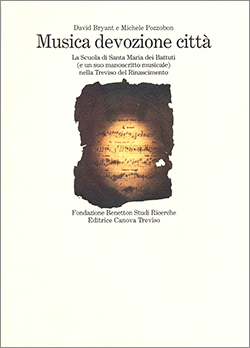
Musica devozione città
La Scuola di Santa Maria dei Battuti (e un suo manoscritto musicale) nella Treviso del Rinascimento
by David Bryant and Michele Pozzobon
Fondazione Benetton Studi Ricerche-Canova
Treviso 1995
256 pages, 34 illustrations
cover price 23 euro, ISBN 88-86177-64-X
(Memorie, 4)
The discovery, in a dark corner of the Capitular Library in Treviso, of six music manuscripts and about thirty prints, all of which were seriously damaged in the blaze caused by the bombing raid on 7th April 1944 (though they were not destroyed, as had previously been thought), led to an astonishingly enterprising project involving sophisticated scientific photography, restoration of the blackened pages and historical research concerning their contents. A first codex, Manuscript 29, takes us a long way from music-making in the Cathedral and sheds light on an aspect of music history in Treviso which has links with many of its churches and a confraternity which, despite its prominence in the city has received little attention from music scholars: the Confraternity of Santa Maria dei Battuti. It engaged musicians on well over a hundred occasions every year for masses, complines, burials, sacred performances, popular festivities and most of all for processions. Music for a substantial number of these responsibilities is to be found in Manuscript 29, which makes it one of the very few collections of music to be linked directly to the activities of a confraternity in xvicentury Italy. The codex, which dates from the years 1580-1582, contained 176 pieces, including a number of unicaand sixty or so contrafacta. The bizarre changes made by the cathedral priest and cantor who compiled the collection show that he himself certainly wasn’t a composer but perhaps offer evidence of what happened to much Renaissance “art music” when it came to the multitude of everyday demands a practising musician had to deal with.
Contents
Tavola delle abbreviazioni, 6
Prefazione, 7
Introduzione, 9
I. Oltre il Duomo: le chiese e le confraternite, 15
II. Messe, vespri, compiete e processioni, sacre rappresentazioni (e feste mondane): la musica nelle funzioni della Scuola dei Battuti, 25
III. Un’ipotesi di repertorio polifonico: il manoscritto 29 della Bi blioteca capitolare di Treviso, 63
IV. La compilazione del manoscritto 29 e i suoi primi proprietari, 77
V. Funzione e stile: le musiche del manoscritto 29, 97
Conclusioni, 115
Appendici
1. I testi del manoscritto 29, 120
2. I brani musicali, 154
3. Il restauro di un manoscritto bruciato (padre Gerardo Garegnati e don Giacomo Pedron), 220
4. Tecniche fotografiche utilizzate per la restituzione dei testi del manoscritto 29 (Massimo Tosello), 224
Bibliografia citata, 231
Indice dei nomi e delle cose notevoli, 235
